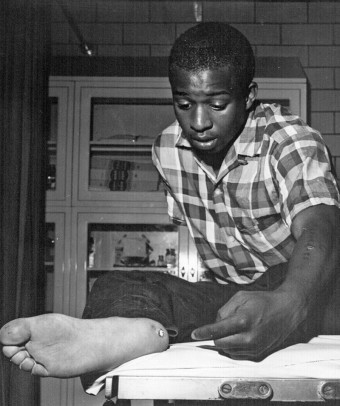‘Contagion’ examines black bodies in public health

“Contagion,” on display through February, highlights how public health campaigns discuss black bodies.
Visual arts, dance concepts, understanding of epidemics and the UIC student experience will highlight how past and present health campaigns communicate about the health of black bodies in an exhibit on display at the School of Public Health.
“A Choreography of Contagion: Absence and Presence of Black Bodies in Public Health Campaigns” shows how narratives, symbols and images are used in global health campaigns about bodies of African descent. The exhibit was displayed on the east side of campus during fall semester and moved last week to the UIC School of Public Health Activity Room (160 SPHPI). Parts of the exhibit, presented by the African-American Cultural Center and School of Public Health, will be rotated in the lobby throughout February to honor Black History Month.
“‘Contagion’ is a teaching and learning tool, a way to convey information in a visual and interactive format,” said Lori Barcliff Baptista, director of the African-American Cultural Center.
Baptista commissioned “Contagion” with the support of Ebbin Dotson, assistant dean of urban health and diversity programs and assistant professor of community health sciences. Curated by Mario LaMothe, postdoctoral associate at Duke University, the exhibit includes newspaper articles and images or photographs from health journals, private institutions and popular media.
Six student facilitators, each from the School of Public Health, will guide visitors through the installation.
“Students identified some personal issues and concerns or areas of expertise that they had as a way to relate to the content,” Baptista said.
“Viewing the exhibit through the interpretive view of students, visitors might learn something that they didn’t know before; they might think about something that they did know a little bit different and consider what action they’ll take as a part of their work, study or daily life that reflects these new discoveries.”
Micquel Hart, a master’s student in the School of Public Health, said the exhibit covers public health history she previously did not know.
“I can only imagine that the rest of the black population, even just in Chicago, has no clue about some of these things,” she said. “So, being a black woman, I think it’s really important to encourage other members of my racial ethnic group to become aware of the history of black health in America, what it means to be black, how that has impacted lots of health outcomes that don’t stem from individual behaviors and how the system can shape some of these chronic diseases that are afflicting the black population more than others.”
Jessica Roach, also a master’s student in the School of Public Health, says facilitators have another important role: “making it human.”
“It’s incredibly important to have a place where we can find a space to feel safe, that we can express what our experience is and have that be met with a level of respect and care,” she said.
Hart hopes the exhibit will inspire dialogue on current public health disparities.
“Knowing the history of it all can set the precedent for what we can do in the future,” she said. “And that’s a driving force in public health — to do more.”
For more information, call 312-996-9549 or email
uicaacc@uic.edu
Categories
